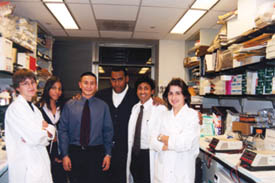|

Sloan-Kettering
Researcher Makes Difference in Lives of Three HS Students
By
Marylena Mantas
Last
winter Dr. Sat Bhattacharya, a research scientist at Memorial
Sloan-Kettering Cancer Center in New York City, ventured into
inner-city, public high schools searching for students who possessed
a certain motivation and something that he calls “the initial
spark.”
“I
wanted to influence more minds,” he said. “I wanted to go below
the university level and get students interested and motivated
in science.”
He found one of them at the Frederick Douglas Academy in Harlem
and two at the Union Hill High School in New Jersey. The students–Tray
Vone Anderson, a senior at the Frederick Douglas Academy, Rina
Shah a junior and Paulo Lizano, a senior at Union Hill HS—spent
the summer of 2001 at Sloan-Kettering conducting research in the
molecular detection of circulating cancer cells in blood and bone
marrow in various types of cancer, including breast, prostate,
melanoma, lung and thyroid cancer.
The knowledge they acquired during the internship, which was funded
by a grant from the American Chemical Society’s project SEED (Summer
Experience for Economically Disadvantaged Students), was put to
the test at the National Poster Presentation sponsored by the
New Jersey Chemical Society, last September.
The student rose to the occasion and excelled, as Lizano came
in first place and Shah second out of the 140 students that presented.
The high caliber of their work was also acknowledged when Lizano
and Anderson were among the 10 students from the Metropolitan
area selected to present at the National Convention of the American
Chemical Society held in Chicago last summer.
“Their
presentation and the research were considered among the best of
the best nationally,” said Dr. Bhattacharya. “I am proud of my
students.”
The awards and honors, came after three months of challenging
work, as the students spent long hours in the lab, attended seminars,
and wrote papers. Yet, hard work did not intimidate these students,
whose acute spirit of team-work and determination is evident.
“The
internship gave me a chance to work in the lab and experience
the field,” said Shah. “All students don’t get this type of an
opportunity. It was a lot of work. But, I’m glad I took the opportunity.
It gave me hands-on experience. That’s how you learn best.”
These days, the students laugh when they recall their first days
at the lab and their initial feelings of fear of making a mistake.
“The
first day, I felt that I had two shadows watching me,” said Anderson,
who is interested in computer science. “If I had a computer science
internship the worse thing that could have happened would be for
my program to fail. Our work here was crucial in detecting cancer.
We were doing real work and working with real blood.”
Lizano who was interested in medicine and engineering was looking
for a summer internship that would help him decide what career
path to follow.
“It
was a great opportunity and exactly what I was looking for,” he
said, adding that the internship allowed him to realize that he
wants to stay in the field of medicine. “I did not know the specifics.
The micro level.”
According to Dr. Bhattacharya, the students worked with cutting
edge, patented technology. They were joined by a graduate student
and were in daily interaction with other researchers.
“No
one made us feel that we were two inches long. They took the time
to help us,” said Shah. “The environment was great. I was surrounded
by people in a career that I am thinking about pursuing. It encouraged
me.”
Yet, the students indicated that the major source of encouragement
and motivation came from Dr. Bhattacharya.
“Dr.
Sat has been my first mentor,” said Anderson. “I am thankful this
been so good. He had a personal way of explaining concepts. We
need more teachers like that.”
Very often, mentoring transcended lab related material. “Dr. Sat
was the best. I had conversations with him about things not related
to the research. Career options, schools,” said Lizano. “He made
me feel that he is the kind of person that I can come and talk
to. I never had that with anyone else.”
Hoping to expand the program and reach out to more students, Dr.
Bhattacharya has been working with the Board of Education. He
plans to bring individuals whose work is related to science into
the schools to give presentations and attract students to work
with them on year-long internships.
That, as he explained constitutes the short-term goal. The long
term goal? To get the neighborhoods from which the students come
from involved in the project.
“In
order for the impact to be really tangible it has to spill over
to the community,” he said.
For now, Dr. Bhattacharya continues to motive and inspire his
own three students.
“If
there is the best you have to be better than that,” he tells them.
“Enough is not enough. You always have to move forward.”#
Education Update, Inc., P.O. Box 20005, New York, NY 10001. Tel:
(212) 481-5519. Fax: (212) 481-3919. Email: ednews1@aol.com.
All material is copyrighted and may not be printed without express consent of
the publisher. © 2001.
|

